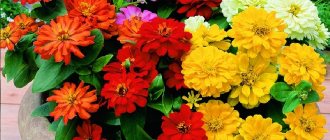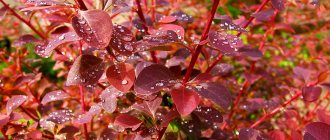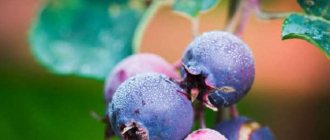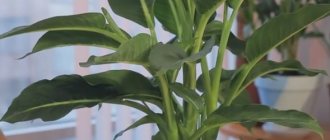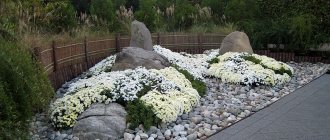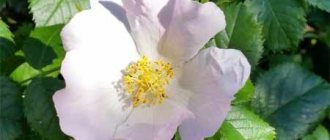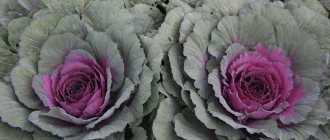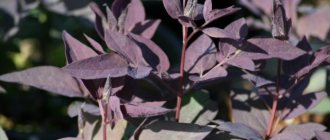The genus of herbaceous annual and perennial plants Heliopsis (Heliopsis) is a representative of the Asteraceae or Asteraceae family. In nature, they can be found in North and Central America. The name of the plant, heliopsis, is translated as “sun-like”, this is explained by the fact that the shape of the inflorescence is very similar to a real sun. This genus includes more than 10 species. The typical species of this kind is sunflower heliopsis (Heliopsis helianthoides); it is its hybrids and varieties that are most often cultivated by gardeners.
Features of heliopsis
The Heliopsis genus includes approximately 15 species of annual and perennial plants. The varieties differ from each other in height and look great in every flowerbed. Heliopsis belongs to the Asteraceae or Asteraceae family and is distinguished by an upright growing stem with many branches that adorn lush flowers. The most common type of this plant grows up to 90 cm in height and has white leaves. The remaining varieties have green leaves with an oblong shape and notches along the edges. The root system is mainly represented by adventitious roots (fibrous).
The flowers of the perennial are yellow with an orange tint. Their baskets can be simple, collected in inflorescences, or terry. The flowering period begins in late June; in warm conditions, heliopsis blooms earlier. Flowering duration is up to 75 days.
Heliopsis in landscape design
These simple flowers are perfect for a garden in a rustic or Provençal style. They will complement a flower bed with phlox, delphinium and calendula, and create a voluminous sun spot on a green background. You can choose tall varieties for decorating a fence or short ones for flowerpots and the front edge of a flower bed. Varieties with decorative leaf coloring will begin to delight with their grace even before flowering. Having a pleasant smell, heliopsis will attract butterflies and bees to your garden.
Varieties and varieties
Of the 15 species of heliopsis, only the sunflower-shaped one is grown as a garden crop. Based on it, a variety called rough heliopsis was bred, characterized by its resistance to low temperatures and many inflorescences. From it, British breeders obtained a number of varieties, many of which were awarded the Royal Horticultural Society, which is quite prestigious in the UK.
Sunflower
Sunflower heliopsis is a perennial with branched stems that grow straight and reach 100 cm in height. The variety is characterized by solid leaf blades, with notches along the edges, and the leaves themselves have an opposite arrangement. They bloom profusely and continue throughout the summer. The inflorescences can be double or semi-double, their color is golden yellow, the maximum diameter is 9 cm.
Rough heliopsis
The height of a bush of this species reaches 1.5 m. Branched stems complete rough crowns that harden over time. The leaf blades are distinguished by their oval shape and a serrated edge. The inflorescences of rough heliopsis externally resemble small baskets with a diameter of 60-75 mm, in which flowers are located in the form of golden tubes.
Lorraine Sunshine
Heliopsis of this variety is characterized by ease of care and a pleasant light aroma. Its simple inflorescence is a basket framed with yellow petals. The maximum height to which flower stalks rise is 75-80 cm.
A characteristic feature of the variety is the attractive color of the leaf blade: white with green veins.
The flowering of the shrub is expressed by a large number of yellow baskets on its “cap”.
Summer Knights
This large variety of heliopsis, bred by American breeders, grows up to 1.2 m in height. The bush is distinguished by a brown stem and bronze leaves. The flower is a simple one; the center of the inflorescence is decorated with an orange core with a red tint.
General information
Heliopsis is a representative of the Asteraceae (Asteraceae) family. It has characteristic features: straight, strong trunks, leaves with jagged edges, arranged alternately or opposite each other.
The inflorescence is a basket, consists of two types of flowers: yellow ligulate along the edge and tubular dark brown central ones. Depending on the variety, they can be double or semi-double, and have different colors of inflorescences.
The fruit is an achene that ripens well in temperate climates.
The plant forms a growing clump.
Growing from seedlings
Containers made of any material are suitable for seedlings, as long as there are drainage holes at the bottom to remove excess moisture. In addition, the bottom should be lined with a layer of expanded clay 1.5 cm thick. When planting, the seeds are first evenly laid out on the surface of the soil, and then pressed into it to a depth of 2 mm. The soil is moistened with a spray bottle, and the container with plantings is covered with film on top.
Proper storage of seedlings involves keeping them for 7 days in a room with good lighting and a temperature of at least +20 °C. After this period, the seedlings are moved to a cool place, where they are stored at a temperature of +3 to +4°C for approximately 30 days. After a period of stratification (hardening), the plantings are returned to their previous conditions, where they ripen at a temperature of +25°C.
After the first pair of leaves appears, the covering material is removed and the seedlings are transplanted into new containers.
After the picking procedure, the seedlings are kept at a temperature of +15 °C.
Since heliopsis seedlings need to be planted in open ground in early May, it is recommended to sow seeds in February - March. In May, young plants are planted, taking into account the following:
- the distance between seedlings in a row is 35-40 cm;
- the interval between rows is 65-70 cm.
To avoid damaging the root system, it is recommended to thoroughly moisten the soil before removing them from the container.
The perennial heliopsis flower tolerates replanting well; if it is taken out together with a clod of earth, the risk of disease is significantly reduced.
It will take approximately 10 days for the shoots to fully root. During this period, abundant watering is required.
Where and how does it grow
Despite the fact that heliopsis can be found in almost every “grandmother’s” garden, its historical homeland is North America. Now this plant has spread throughout most of the globe, as it has good frost resistance. Thus, even in regions with harsh winters, heliopsis “overwinters” without appropriate shelter.
This plant grows better and more decoratively in sunny open areas, characterized by moderately fertile soil with a neutral reaction (if the soil is overly nutritious, then the plant grows herbaceous shoots and foliage to the detriment of flowering). In the shade or partial shade, this flower is prone to poor flowering and excessive elongation of shoots.
You should also take into account that heliopsis grows quickly, so when choosing a place, you need to think about the need for regular weeding of the growth.
Planting seeds in open ground
The procedure is quite simple: you need to place one seed at a time on a small bed. In this case, the following rules should be adhered to:
- Maintain an interval between beds of 60 to 70 cm.
- Provide the required distance between the seeds - from 20 to 30 cm. After they grow, it is necessary to replant or remove every second bush so that they do not interfere with each other’s growth.
- The depth of the furrows should be from 2 to 3 cm to make the path of heliopsis to the sun easier.
If planting is done in the fall, then it is better to water in October, and in case of warm weather, postpone it to November.
In the spring, March-April is a suitable period for this purpose; after the soil dries out, you can sow heliopsis. If for some reason it is not possible to sow the seeds, the procedure can be postponed until May or June.
Benefit
Heliopsis is, first of all, an ornamental garden plant that, without exaggeration, will successfully fit into the design of any garden (especially if the garden is designed in a rustic or Provence style). It will look impressive if planted near a wicker fence, wooden wall or old cart. Heliopsis goes well with sage, liatris, speedwell, cornflowers, etc.
Caring for plants on the site
Like most garden crops, heliopsis is unpretentious in care. For their full growth they require:
- regular and timely watering;
- weed elimination;
- removing the growing point on the stem so that the flower begins to grow in width;
- eliminating faded inflorescences.
As the flowers grow, their stems are tied to pegs located next to them.
Transfer
When they grow in one place for a long time, the flowers become very dense and begin to occupy new places on the site. To solve this problem and maintain the decorative appearance of plants, they are replanted once every 5-7 years. The process is not complicated and is carried out using the same technology as planting seedlings in open ground.
Watering
Since heliopsis belongs to the southern plants, they tolerate hot days and long droughts well. However, if there is a lack of moisture for a long time, this will negatively affect flowering: the splendor and duration will decrease. Therefore, on hot and dry days, it is recommended to water the flower 2-3 times a week. The time for this should be chosen either morning or evening, and use only warm water.
Top dressing
If the soil is properly prepared for planting heliopsis, fertilizers will only need to be applied in the second year of their growth. Feed the bushes once every 30 days, using a universal composition for garden crops with organic matter.
Trimming
Carried out in the following cases:
- correction of the shape of the entire flowerbed;
- removal of damaged and dried stem fragments;
- preparation for wintering.
Wintering
Heliopsis tolerates winter easily. As a rule, they stop blooming by mid-autumn. At this time, the bushes are trimmed flush to the ground. This procedure will be quite sufficient for wintering; the plant does not require additional shelter.
Do you like heliopsis?
Yes
No
Description of the plant
Heliopsis (lat. Heliopsis) is a herbaceous plant from the Asteraceae family, a typical representative of this group. Its main varieties look like small sunflower flowers, and some are much more interesting.
There are more than 10 species of the genus Heliopsis, but in our country one species of Heliopsis helianthoides is grown - Heliopsis sunflower or sunflower. This plant grows in North America. Thanks to its beauty, it has spread almost throughout the world.
Botanical description:
- Heliopsis sunflower is a perennial herbaceous plant.
- The stem is 75-150 cm high, hard, erect, roughly pubescent, usually unbranched.
- Leaves are opposite, toothed, rough, pubescent. The edge of the leaf is serrated.
- Flowers - collected in a basket with a diameter of up to 10 cm. Flowering period: from June to September. The flowers consist of an inner small "eye" and surrounding long tongue-like petal-like flowers. As a rule, they have an intense yellow color. Flowers are simple, semi-double or double, growing singly or collected in loose panicles.
Heliopsis shoots are similar to sunflower shoots. Stiff, short hairs cover the stem. However, its flowers are most interesting. They develop on the tops of shoots in mid-summer and persist until October, very similar to the flowers of asters or sunflowers.
Diseases and pests
Of the pests for shrubs, the black aphid poses the greatest danger. It is important to periodically review the condition of perennials and, if parasites are detected, immediately treat with tincture of wormwood or celandine (containing soap). If the infection is significant, it is necessary to cut off the diseased plants at the very base and burn them outside the garden plot, and treat the unaffected remains of the bush with an insecticidal preparation.
Heliopsis can also suffer from powdery mildew or rust. To get rid of these diseases, fungicidal agents are used.
Possible problems in growing
The perennial can also experience problems and diseases, although this is rare for this plant.
The most common difficulties:
- Problems with leaves in variegates. They arise as a result of excessive watering or damage to certain diseases.
- Pests. Heliopsis Sunflower does not attract the attention of many pests. In hot weather, it can be affected by aphids, which are treated with standard insecticides - Fitoverm, Aktara.
- Diseases. The plant can be affected by powdery mildew and other fungal diseases. Take the usual measures to combat such diseases.
- Signs of improper care. If the rules are not followed, the plant may “hang” its leaves, bloom poorly, and the inflorescences appear small.
Heliopsis variegated is a beautiful and unpretentious plant that even a novice gardener can grow. The choice of varieties is huge, so everyone will choose a flower to their liking.
Reproduction methods
Heliopsis reproduces in only two ways: by dividing the bush and by seeds.
Dividing the bush
This method is used both in spring and autumn. An adult bush, growing for about 5 years, is removed from the ground and its root is thoroughly washed. Then the rhizome is divided into parts so that each of them has at least one bud. They are planted in the ground in the usual way.
Seeds
Propagating heliopsis by seeds is the most convenient way for gardeners. Seeds can be collected from perennials yourself or purchased at the store. In the first case, you will need to collect the baskets before they fall to the ground.
It is advisable to stratify seeds stored for more than a year.
Description of the species of perennial varieties of Heliopsis helianthoides
Common indoor variegated ivy flower
There are about 15 species of heliopsis. Some of them are perennial, while others, on the contrary, grow only for one year. Varieties differ in appearance and have certain characteristics.
Sunflower
This type includes classic plants. Heliopsis sunflower reaches 1 meter, the leaves have serrated edges, there are few of them. The inflorescences are large, bright yellow. The core resembles a chamomile, but is larger in size.
Variegated
Plants of this species are distinguished by the variegated color of their leaves. Due to the presence of mutant cells that are unable to produce chlorophyll, light spots and veins gradually appear on the leaves of Heliopsis variegata.
Variegated heliopsis
Rough
Also classified as sunflower. The length of rough heliopsis reaches one and a half meters. The plant is distinguished by large buds and large flowers, the leaves are large and rough to the touch.
Terry
Terry varieties are distinguished by inflorescences with a large number of petals, which makes the flower voluminous and gives it an attractive appearance. These types of terry heliopsis look very elegant.
Other
Quite a few varieties of the plant have been developed. They differ in height, shade of petals, and splendor of inflorescences. Some varieties have few petals, and they are arranged in a couple of rows - these are smooth or simple “baskets”. Those with a little more of them are classified as semi-double varieties.
Planting and propagation of plants
Heliopsis is a plant that spreads quickly in the garden. Sprouts and seeds can independently conquer new territories. In the garden, for the plant, you can take the far corner in the depths of the flower bed, since planting and caring for heliopsis is minimal.
Growing
Growing new plants is a simple process. Despite the fact that the plant can grow in one place for decades, it is recommended to plant it every 4-6 years. If this is not done, the bush will become very thick and the flowers will be smaller. The distance between young bushes should be at least 40-60 cm.
Reproduction
There are two ways to grow a young plant. Dividing rhizomes and seeds.
Dividing the bush
Heliopsis is a herbaceous plant for open ground in temperate latitudes; it tolerates wintering well. Propagation by dividing the rhizome can be carried out both in autumn and spring. To do this, dig up an overgrown adult plant (4-5 years old). The rhizome, cleared of soil, is divided into parts with a sharp and clean knife so that there is a sprout on each root, then planted in a new place. The new planting area is first loosened and fertilized. If the soil is clay, provide good drainage and water thoroughly, especially in the first weeks after sowing, avoiding drying out of the soil. Heliopsis planted in this way begins to bloom this year.
Growing from seeds
Good and fast sprouts come from fresh seeds. They can be planted before winter (October-November) or in spring (March-April). Seeds for seedlings are sown in February, and the plant can be transplanted into open ground in May. Seeds that are stored for more than a year must be stratified. Place them in damp material or soil (napkin, sand is also fine), cover with plastic and refrigerate for 30 days.
You can plant seeds on any nutrient medium, even for indoor flowers. Heliopsis seeds can be planted immediately into individual containers, one seed at a time. When planting seeds in a common box, it is necessary to maintain a distance between seeds of at least 5 cm, the sowing depth should not be more than 1 cm. There must be holes and drainage at the bottom of the containers. You can speed up the germination process by covering the seeds with film. Shoots will appear within 2-3 weeks. Choose a well-lit window for the seedlings.
Hardening begins a month before transplanting the plant into open ground. When taking seedlings into fresh air, first remove the film for an hour, and then increase the time.
Preparing for winter
After the end of the growing season, the upper part is cut off at the base and left to overwinter in open ground. The plant easily tolerates frosts in central Russia. Dry shelter is necessary if winters are hot and humid. To do this, you can use sawdust, spruce branches and other specialized roofing material.
Preparing heliopsis for winter
As mentioned above, heliopsis are unpretentious, hardy and resistant to severe frosts. For this reason, plants do not require any special shelters for the winter.
Heliopsis does not need winter shelter
To preserve the flower until next year, it is enough just to trim the greenery before the onset of frost, and we can assume that the perennial is ready to spend the winter.
Secrets of success when growing heliopsis
- Clayey but well-drained soil in the area for planting them.
- You should not indulge in heliopsis with too rich humus or soil - the plant will begin to gain weight due to flowering.
- He just needs a sunny place. In the shade, heliopsis blooms worse, stretches and is more susceptible to the disease that most often occurs in it - powdery mildew.
- The plant does not need frequent watering.
- Heliopsis grows successfully without shelter even in Siberia, BUT! It can explode for years due to frequent thaws and in the spring in heavily flooded areas.
- Timely removal of wilted baskets promotes abundant and uniform flowering.
© 2022, Garden landscaping. All rights reserved.
Related Posts
Snapdragon - very cool and not scary at all
Dicenter of a broken heart
